Episode 197
What you’ll learn in this episode:
- Why all jewelers need to understand the durability of the stones they work with
- How Sally designed her book to be a quick reference for jewelers with minimal gemology knowledge
- Why consumer protections for gemstone quality are lacking, and why jewelers need to take up the mantle for this issue
- What Sally covers in her gemstones for jewelers classes
- Which unusual stones jewelers should take a second look at
About Sally Spencer
Obsessed with jewelry and gemstones, Sally Spencer has been designing and making jewelry since 1995. Her love affair with stones started when she was small, spending many happy hours collecting pebbles on the beach. The stones may have become more expensive over the years, but she is still fascinated by them and has studied both colored stones and diamonds with the Gemological Association of Great Britain (Gem-A). As a Fellow of Gem-A, she continues to love researching about gems and teaching gemstone courses. She is the author of “Jewelers’ Quick Reference Guide to Working with Gemstones,” written specifically for jewelers to live on the bench, ready to answer queries when designing or working on a piece of jewelry.
Additional Resources:
Sally’s Website (Book available on her website)
Photos:
Sally’s Book (available on her website)
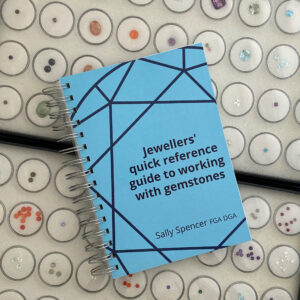
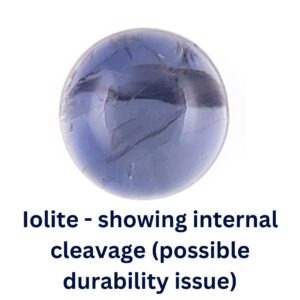
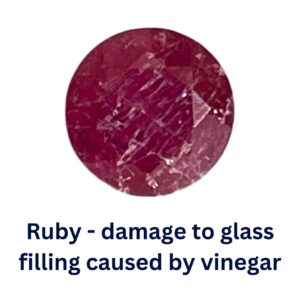
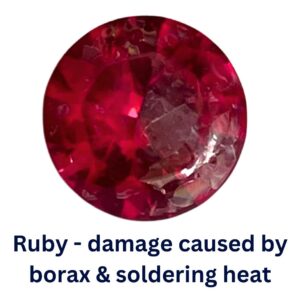
example table page:
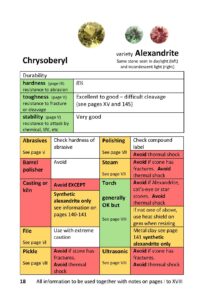
example information page:
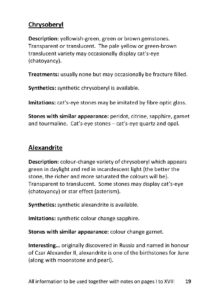
K2 granite with azurite
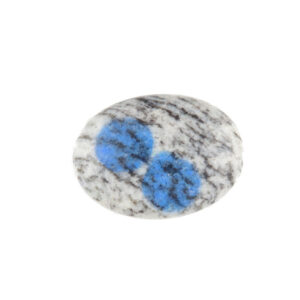
Transcript:
Gemology is such a vast field that it’s impossible for a jeweler to understand everything about the stones they’re working with. That’s where Sally Spencer comes in. As an educator and author, Sally is passionate about teaching jewelers and consumers about the qualities of the stones they’re buying—or think they’re buying. She joined the Jewelry Journey Podcast to talk about the issue with mislabeled synthetic and treated stones; the one thing that every jeweler who works with stones must understand; and why she hopes to see more consumer protections and verification options for gemstones. Read the episode transcript here.
Sharon: Hello, everyone. Welcome to The Jewelry Journey Podcast. This is the first part of a two-part episode. Please make sure you subscribe so you can hear part two as soon as it’s released later this week.
Today, we’re talking with Sally Spencer from the U.K. You may already know Sally if you’re a jeweler. You may have her most recent publication, “Jeweler’s Quick Reference Guide to Working with Gemstones.” You may have that on your worktable right now. You may know Sally because, if you were a jeweler and you got into trouble with any kind of stone—and by that, I mean perhaps you accepted a stone from a client but you really didn’t know about the stone—you might call Sally and ask her if it can be fixed or if they should buy a completely new stone, depending on what it is. You may have seen Sally at fairs she attends where she exhibits her wares. Perhaps you’ve taken one of her classes and know her through that. In any event, you’ve probably heard of Sally Spencer or at least know of her. We are all going to learn about the rest today.
Sally, you’re the author of “Jeweler’s Quick Reference Guide to Working with Gemstones.” I think I read that title several times. Did you think about writing the book for a long time before you actually wrote it?
Sally: I did. Thanks for having me on with you today. I’m looking forward to chatting gemstones with you.
Sharon: I’m so glad we connected.
Sally: I did think about the book for a while. It was in the back of my mind because, as I was teaching jewelers to make jewelry, I would occasionally see, out of the corner of my eye, that they were about to do something with a gemstone that was not going to land well for that gemstone. I kept thinking, “If they just had a little bit of gemological knowledge, they wouldn’t attempt to do that.” I wanted to know, over the years, how many gemstones are inadvertently destroyed by jewelers not having that extra bit of information that could make their life easier, and potentially save them money as well by not having to buy a replacement stone.
Sharon: I’m surprised to hear you say that jewelers don’t know that much about gemstones. I shouldn’t be surprised. I’ve taken classes where they teach you about diamonds but nothing else. I am just surprised that jewelers don’t know about gemstones, or at least they don’t find out what they’re working with before they use it. I would be afraid to give one of my precious pieces to somebody and say, “Fix it,” when they don’t know what they’re working with.
Sally: It is a modern field. I learned a lot about gemstones over the years, but there is so much more to learn. Even now that I have my qualifications, every day I learn something new. Every day I discover something about a gemstone, and that sends me down a different path to research something else, not necessarily about that gemstone. It might be about another one within its family. It’s a massive, massive subject.
Jewelers don’t need to be gemologists. They don’t necessarily need to know crystal structures or how stones interact with light or different inclusions, but the one thing they really do need to be more aware of is the durability of a gemstone. That covers its hardness, which is its resistance to scratching; its toughness, which is its resistance to breaking under pressure; and its stability. It will all change if it’s subjected to chemicals or heat or ultraviolet light.
I think, as a minimum, that should be taught to jewelers, particularly in the university courses where they’re gaining a lot of information about making jewelry. That will take them to the next level and give them an even greater understanding and readiness for when they’re out there making their own pieces of jewelry.
Sharon: That’s a good point. I have learned about crystal structure at a top level, but I’ve never had to think about it, really. Would you say that writing the book has increased your business?
Sally: It changed my business. It changed my focus. It came about during all the lockdowns with Covid because, like everyone else, everything stopped. All my classes, all my shows stopped. I have worked all the time since I left school, and I didn’t like being stuck, twiddling my thumbs wondering, “What do I do? I don’t understand. What’s going on?” I thought I needed something to focus on. While the world around us was going completely crazy, I needed something to focus on and lose myself in for a little bit of mental clarity and mental peace. I thought about this book I’d been thinking about off and on over the years, and I thought, “Well, let’s make a start.”
Every day I would sit down at the computer and sit down with my books, do more research and start planning it out. Then I got all the information together and looked at how I wanted to lay it out. As a bench jeweler, what would be quick and easy to use? So, then I worked on the layout. There was a group of five of us who were all jewelers. I would say to the four other amazing ladies over Zoom or email, “Does this make sense? Do you understand what I’m trying to say here?” None of them are gemologists, so I knew they were looking at it purely as jewelers. Then I had the entertaining time—entertaining is not the right word—it was especially frustrating and drove me absolutely crackers—of trying to photograph all the different stones I wanted to illustrate in the book because, as we were in the middle of Covid, I couldn’t go anywhere or see anyone. I didn’t know who to contact, and I thought, “I’m just going to have to get on and do this myself.”
By the end of the lockdowns, I had pulled together the quick reference guide. I still can’t quite believe I did it, that I actually got to the end and got it printed and it’s out there. The thing I find astonishing—and I almost have to pinch myself—is that it’s being used in over 20 countries. I just find that mind-blowing. It’s out there doing what I hoped it would do, sitting on jewelers’ benches. If they’re sat there working a stone with a bit of heat, if it’s all going to go wrong, they can very quickly look in the book and have some reassurance of “No, just don’t,” or “Yeah, that will work. That’s fine.”
I still can’t believe it, Sharon, but the whole experience during the lockdowns altered the course of the business. It took my focus away from making jewelry to thinking, “I really want to help other jewelers understand stones better.” Then taking it a step further, I want them to understand what they’re buying. There are some absolute horrors out there being sold, where treatments aren’t being disclosed. This is where a gemstone has been artificially altered by man to improve its color or its clarity or its durability, which is absolutely fine. I have no problem with that at all. What I don’t like is when people do it and they don’t disclose it. They don’t tell the person who’s buying stones from them, and that trickles on to their customer because if the jeweler doesn’t know, they can’t tell their customer. I would really like to get jewelers and their customers more aware of the big, wide world of gemstones and give them a little bit of insight into it. Sorry, that was an extremely long answer.
Sharon: No, it’s a good answer. As reality settles in and you realize you wrote this book, have you been thinking about a second edition or a different book?
Sally: I am working on a book about buying gemstones. There are some incredible books on the market. I have bookshelves full of wonderful books about gemstones. The information that’s in “Jeweler’s Quick Reference Guide” is out there, but it’s buried deep in lots of different textbooks. If you’ve sat at the bench, time is money, and even as a jeweler, you don’t necessarily have these gemology books. You just want to know, “Can I do this?”
There are incredible books about buying gemstones, but I want to do a similar, quick-reference guide to buying gemstones to give people a heads up. I can’t make them gemologists through osmosis through a book; I really wish I could, but I can hopefully give enough information that they will feel confident to say to somebody, “Is this gemstone treated?” and if the person they’re buying it from says, “I have no idea. What do you mean?” or, “It doesn’t matter,” that in itself tells me something about the person they’re buying it from. They’re making a far more informed purchase than just trusting and believing what they’re being told what’s in front of them. Without this little bit of background knowledge, they wouldn’t necessarily know to question it.
Sharon: Do they sometimes call you before they purchase something? Do they call you and say they don’t know?
Sally: No. It’s more trying to get the information out there at the moment, writing magazine articles. You very kindly invited me on your podcast. Just trying to get this information out there to make people more aware. Doing talks. I love doing talks. I can talk for hours about gemstones. It takes a while to shut me up.
Sharon: We have a lot of time. You have an FGA and a DGA. Are they licensed separately? What are they?
Sally: When I wanted to learn more about gemstones in a more structured way, rather than doing bits of ad hoc research myself over the years, I looked into qualifications. I decided to study with The Gemological Association of Great Britain, and the FGA initials are a Fellow of the Gemological Association of Great Britain. I studied and passed their colored stones gemology declaimer. The DGA is their diamonds declaimer. I studied and passed that one first because I don’t like chemistry, and I knew there was going to be some chemistry involved in this. I thought, “Diamonds, carbon. I can cope with one chemical element. Let’s go for diamonds. Let’s give that a go.” They chucked in a little bit of nitrogen and a little bit of boron, and I thought, “Hey, I’ve tackled three. I’m doing well.”
I had the most amazing tutor. She gave me so much confidence and pleasure in my studying that I thought, “You know what? I’m going to tackle the colored stores. I’m going to tackle all these other chemical elements that I’m not very good at. I’m just going to go for it.” I was fortunate enough to have her as my tutor for the first year of that course as well. A wonderful, wonderful lady. I can’t thank her enough.
Sharon: Did you have to go to the Gemological Association and take their basic course before the diamonds and colored stones?
Sally: I did online distance learning because I’m some distance from the physical building of Gem-A. That was quite a challenge. You had to be very disciplined and sit down and study the set material for the week because if you didn’t, you could quickly fall behind. Then we did intensive lab courses where we went in and did an intensive week studying the stones, putting into practice all the theory we’d been learning. Then on Saturday, we had the exam. They were intensive weeks.
Sharon: I bet. I know here with the colored stone tests, they give you three stones, let’s say—I don’t remember—but you do it once and that’s it. You get it right or you get it wrong and that’s it. You don’t do it again. It’s that simple.
Sally: You can retake the exam again, but you have to wait. I can’t remember now. I think you have to wait until the next round of exams, which for many means they have to wait six months. It reminded me why I disliked exams at school. When I got to the end of them, I must admit I said, “That’s it. I don’t want to do another exam again.” I find them quite stressful. I think that is the best way of putting it. I put myself under a lot of pressure, but I’m pleased to say I got through them all intact.
Sharon: It sounds like you accomplished a lot. I don’t work in the business, so I can’t imagine learning the stones without being somebody who works with them every day or, like you said, knows what the problem is. Were you already teaching classes when you did this?
Sally: At the time, I was teaching jewelry making in a school as part of a GCSE and A-level design and technology class. I was teaching 14- to 18-year-olds, which was so much fun. It made me look at teaching in a completely different way. Being around them as they discovered they could make something and it looked good, and then they could wear it with pride, was an incredible feeling. I think four or five of them have followed me into the industry. I cannot tell you how proud I am of them all. They are all amazing. It was such a privilege to be there as they discovered a shared passion for jewelry. It was incredible.
Sharon: I was taken by a word you used in your literature, that you had a passion for gems and gemstones. To me, that’s interesting, but it’s different than jewelry. Usually, people say they have a passion for jewelry and the gemstone comes along with it, but you just look at the gemstone. What’s the difference between a gem and a gemstone, anything?
Sally: No. It’s just an abbreviation, a shortened word. I’m generally not quite sure. I was trying to think back whether it was jewelry first or gemstones first. I think it was possibly gemstones first, then the jewelry started to overtake the gemstones. Then the gemstones fed into the jewelry and have now ultimately leapfrogged the jewelry in the cabinet.
Sharon: When did you start teaching courses on gems? After you wrote the book or during the book?
Sally: Before. I knew that jewelers needed a little more information, so I started trying to give introduction to gemology classes to raise their awareness. Oh, my word, I had so much fun with those, so I started doing that. It was pretty much as I finished my qualifications because I wanted to share the information and get it out there.
Sharon: When you say you had fun, why was it fun?
Sally: Watching them discover what gemstones do and how they react and interact with light. You’ve done your GIA, haven’t you?
Sharon: I haven’t taken the test, but yes.
Sally: So you know that when you look at a piece of glass through a polariscope—which is a piece of equipment that has a light source at the bottom, and then it has cross-polarizing filters so it makes the light wave go in one direction coming up through the bottom filter. Then you cross the top filter so it can’t get through, and then you put a gemstone in between the two and move it around and see how it alters the path of light or interacts with light. It was hearing them saying, “Oh, wow, look at this!” To see a piece of glass in there, showing its strain with this anomalous extinction, if it’s got those rising snakes of black going through, that is just amazing. And showing them dichroic stems with a dichroscope.
Sharon: That’s probably why I didn’t continue. I feel like some people will get the detail and some people don’t. I just don’t. Were you teaching experienced people?
Sally: They weren’t experienced gemologists, but they were jewelers. Some of them were complete beginners at jewelry making; some of them were very experienced jewelers.
Sharon: They made things, but they didn’t know anything about the stones that were in them.
Sally: Yes. They knew what they bought, but they weren’t necessarily aware of the durability properties of the stones, whether it would survive being put in a ring or whether it was softer and less durable and it would better in a pair of earrings. They had to hope they bought from reputable dealers, that the stones were what they were being told they were.
Sharon: Do people call you afterwards and say, “I think I ruined this,” or “I did ruin this. What I should I do next time? What did I do wrong?”

